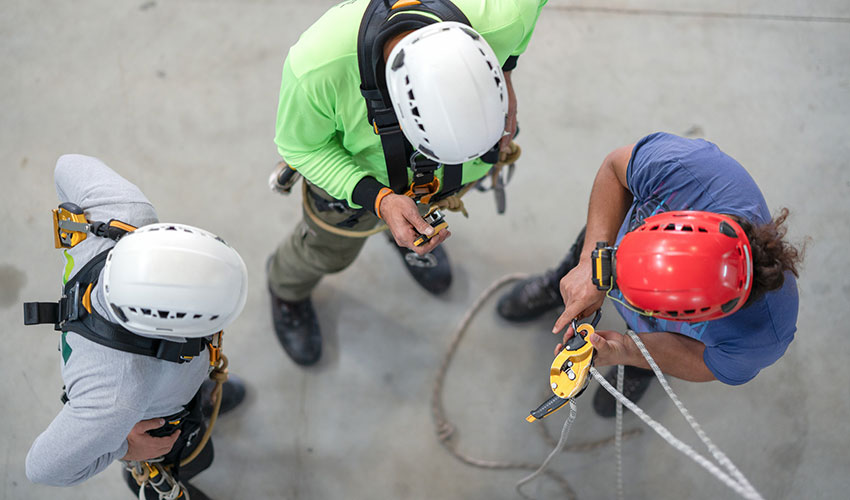5 Steps for preventing construction falls and creating a safer worksite

Work-related deaths and injuries have been on the rise in Singapore. There were 46 workplace fatal injuries in 2022. This translated to a fatal injury rate of 1.3 per 100,000 workers in 2022, which is higher than the rate of 1.1 per 100,000 workers in 2021.1
Whatever the scope of the job — whether it is cleaning services for a building's exterior or replacing the roof of a house — working on a construction site presents the risk of grave injury from an accidental trip or a steep downward plummet. Preventing such falls is critical to improving workplace safety. Construction workers deserve to work in an industry that prioritises safety; here are some best practices to help mitigate the danger of falls at your worksites.
-
Create a culture of safety in which everyone participates.
While, ultimately, it’s the responsibility of management to ensure a safe worksite, everyone at a worksite has a role to play. At the outset of any project, it’s important to:
- Put together a collaborative safety team that includes project field management, engineering, your insurer, and key crew members.
- Provide the necessary resources and equipment for a safe work environment.
- Set the tone and walk the walk by modelling and supporting a culture of “safety first” behaviour, including for subcontractors.
As management can’t have eyes everywhere, workers need to look out for each other’s well-being. Encourage your crews to observe their work area closely and immediately report unsafe conditions – such as unprotected floor openings – or safety equipment that is damaged or being improperly used by colleagues.
-
Develop a proactive fall prevention plan
Prevention is the best “cure” for construction site falls and resulting injuries or fatalities, so proactive, fall specific plans are as important as hard hats. These should be regularly audited and updated; to start:
- Conduct a job hazard assessment (JHA) to identify exposures and involve designers and suppliers as necessary for each stage of the project.
- Institute protocols particular to the project; for example, floor openings may necessitate internal permitting systems around removal, reinstallation, and inspection of guardrail systems.
- Obtain sign-offs to get in writing that contractors and other parties understand and commit to follow the Fall Prevention Plan.

-
Conduct fall prevention training
Require attendance at fall prevention and protection training on equipment and procedures. Consider the following when planning instruction:
- Hold training early and often — ideally, before each stage of work begins, after each job pause or suspension, and when new equipment or procedures are introduced. Include fallen worker rescue reminders; shorter briefings should be held before the start of shifts.
- Focus on proper set-up and use of ladders and scaffolds. Ladder and scaffold related accidents remain a leading cause of worker injury and fatalities.
- Include instruction on Personal Fall Arrest Systems (PFASs). PFASs provide critical safeguards in the event of a fall but only when worn and used correctly.
- Offer sessions in other languages if your workers are not native English speakers.
-
Establish a fallen worker rescue plan
Despite everyone’s best efforts, accidents do happen. When a fall does occur, everyone needs to know what immediate actions to take. An effective plan will outline emergency procedures, medical information, and communication protocols to ensure that injured workers receive treatment as soon as possible.
Also require an accident investigation after any incidents to understand what went wrong and prevent a repeat occurrence. -
Don’t overlook post-pandemic safety challenges
The construction industry is kicking into full gear and remobilising their workforces following the COVID-19 pandemic.
All businesses must take steps to safeguard the health of their employees, such as ensuring social distancing and requiring the use of appropriate personal protective equipment (PPE). However, this “new normal” at construction sites poses its own set of safety challenges — slip, trip, and fall risks may be exacerbated by:
- Obstructed vision caused by safety glasses fogging up from use of face masks.
- Fatigue on warmer days due to restricted breathing when wearing face masks.
- Stress and anxiety about potential COVID-19 infections at the job site.
Take steps to reorient workers to the construction site, review any changes at the site following shut-down, and provide reminders or refresher training about fall protection measures.
No part of this article may be reproduced in any written, electronic, recording, or printed form without written permission of Chubb.
Disclaimer - The content of the above article is not intended to constitute professional advice. Although all content is believed to be accurate, Chubb Insurance Singapore Limited (Chubb) makes no warranty or guarantee about the accuracy, completeness, or adequacy of the content of this article. Users relying on any content do so at their own risk.

Have a question or need more information?
Leave your contact details and our representatives will get in touch with you.